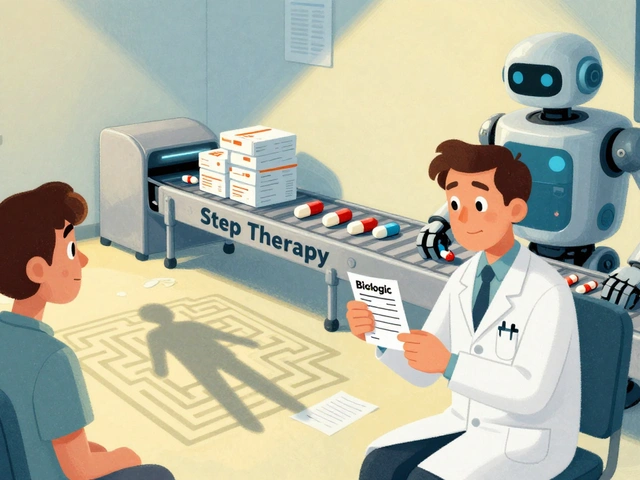INR Target Calculator
Understand Your INR Target
Your ideal INR range depends on why you're taking warfarin. This calculator shows your target based on your condition.
Why INR Monitoring Matters for People on Blood Thinners
If you're taking warfarin, your INR isn't just a number on a lab report-it's a daily lifeline. Too low, and you risk a clot forming in your heart, brain, or legs. Too high, and a minor bump could lead to dangerous bleeding. The INR (International Normalized Ratio) is the only reliable way to measure how thin your blood is when you're on warfarin. Unlike newer blood thinners like apixaban or rivaroxaban, warfarin doesn't have a fixed dose. Every person’s body reacts differently, and even small changes in diet, illness, or other medications can throw your levels off. That’s why regular testing isn’t optional-it’s essential.
What Is INR, and How Is It Calculated?
The INR is a standardized number based on your prothrombin time (PT), which measures how long it takes your blood to clot. Without standardization, a PT result of 15 seconds in one lab could mean something completely different in another. The WHO created the INR system in 1983 to fix this. It uses a formula that adjusts for the type of reagent each lab uses, so whether you’re tested in Birmingham, London, or New York, an INR of 2.5 means the same thing everywhere.
Here’s how it works: your blood sample is mixed with tissue factor and calcium. The time it takes to clot is measured in seconds. That number is then plugged into the INR formula along with something called the ISI (International Sensitivity Index), which accounts for the sensitivity of the testing reagent. The result? A single number that tells your doctor exactly how much your blood’s clotting ability has been slowed down.
What’s the Right INR Range for You?
There’s no one-size-fits-all target. Your ideal INR depends on why you’re on warfarin in the first place.
- For atrial fibrillation or deep vein thrombosis: 2.0 to 3.0
- For a mechanical heart valve (aortic): 2.0 to 3.0
- For a mechanical heart valve (mitral): 2.5 to 3.5
- For some cases of recurrent clots: up to 3.5
These ranges aren’t arbitrary. Studies show that keeping your INR within target reduces stroke risk by 42% and major bleeding by 28% in atrial fibrillation patients. Going above 3.0 increases bleeding risk-each 0.5-point rise above 3.0 raises your chance of serious bleeding by 27%. And if your INR hits 5.0 or higher, you’re in danger territory. That’s when your doctor will likely tell you to skip your next dose and get checked right away.
Home Testing vs. Clinic Visits: Which Is Better?
For years, people on warfarin had to drive to a lab, wait for results, and come back days later for dose changes. Now, home testing devices like the Abbott Acelis and Roche CoaguChek let you check your INR with a single drop of blood from your finger. These devices are FDA-approved, fast (results in under a minute), and accurate when used correctly.
Here’s the real difference: people who test at home spend 72% of their time in the target range, compared to just 58% for those who rely on clinic visits. That might not sound like much, but it translates to 34% fewer clots and 21% fewer major bleeds. One study found that patients using home monitors missed fewer appointments and stuck to their testing schedule 92% of the time-compared to 76% for clinic-based testing.
But home testing isn’t for everyone. If you have shaky hands, poor eyesight, or trouble remembering steps, it can be more stressful than helpful. The FDA reports that 25-30% of patients aren’t good candidates. And while Medicare covers 100% of home testing for eligible users, private insurers often require prior authorization-and even then, you might pay 20% per test strip, which costs around $6 each.

What Happens If Your INR Is Too High or Too Low?
Low INR (below 1.5): Your blood is clotting too fast. You’re at risk for stroke, heart attack, or a new blood clot. If you’re on warfarin and your INR drops below 1.5, contact your provider immediately. You may need a higher dose or a temporary change in your routine.
High INR (above 3.0): Your blood is taking too long to clot. Minor injuries could lead to serious bleeding. If your INR is between 3.0 and 4.9, your doctor might hold your next dose and retest in a few days. If it’s above 5.0, you need to stop warfarin and get medical help right away. In extreme cases, doctors may give you vitamin K or fresh frozen plasma to reverse the effect quickly.
There’s no middle ground here. Warfarin has a narrow therapeutic window-meaning even a 0.5-point swing can make a big difference. That’s why consistency matters: same time of day, same diet, same medications.
How to Get the Most Accurate INR Results
Accuracy starts with you. Here’s what actually works:
- Test at the same time every day-ideally between 8 a.m. and noon.
- Fasting for 4-6 hours before the test helps reduce variability.
- Don’t change your vitamin K intake suddenly. Leafy greens like spinach and kale can lower your INR. Keep your diet steady.
- Tell your doctor about every new medication, supplement, or even herbal tea. Antibiotics, aspirin, and St. John’s wort can all interfere.
- Use the same testing device if you’re doing home monitoring. Switching machines can cause misleading results.
And don’t ignore the small stuff. A cold, stress, or even a change in your sleep schedule can affect your INR. One patient in Birmingham reported his INR jumped to 4.2 after a week of poor sleep and increased coffee intake-something his doctor never would’ve guessed without a full history.
Warfarin vs. Newer Blood Thinners: What You Need to Know
More people are switching to DOACs (direct oral anticoagulants) like apixaban, dabigatran, and rivaroxaban. Why? No INR testing. No diet restrictions. No weekly blood draws. They’re easier-and they cost more. A month’s supply of warfarin runs about $4. DOACs? $550-$650.
But warfarin still has its place. If you have a mechanical heart valve, you can’t use a DOAC. If you have severe kidney disease, many DOACs aren’t safe. And if you’re on a tight budget, warfarin is often the only realistic option.
Here’s the trade-off: DOACs have wider therapeutic windows. You don’t need to hit a perfect number every time. Warfarin? You’re dancing on a tightrope. That’s why INR monitoring isn’t outdated-it’s critical for those who still need it.

What’s Changing in 2025?
New tech is making INR monitoring smarter. In early 2023, the FDA approved the Bayer CoaguChek ProConnect, a device that syncs results directly to your doctor’s system via smartphone. No more handwritten logs or missed calls. If your INR spikes, your provider gets an alert before you even have to pick up the phone.
AI tools like the INR Advisor platform are starting to predict the right warfarin dose based on your history, diet, and lab trends. In a 2022 Mayo Clinic trial, it was 83% accurate in suggesting dose changes-nearly matching expert clinicians.
But access remains uneven. Rural areas in the UK and US still lag behind. Only 35% of rural clinics offer full anticoagulation management, compared to 82% in cities. If you live far from a specialist, home testing might be your best-and sometimes only-option.
Real Talk: What Patients Are Saying
On Reddit’s r/bloodthinners forum, one user wrote: “I used to miss work every two weeks for lab visits. Now I test at home on my lunch break. I’ve saved over £1,000 a year in lost wages and travel.” Another said: “After three years, I still mess up the finger prick one in five times. Wasting $6 strips hurts.”
Patients with mechanical valves overwhelmingly prefer home testing-even if they pay more out of pocket. They cite less anxiety, fewer missed appointments, and more control. But older adults often struggle. One 72-year-old woman in Birmingham told her nurse: “I can’t see the numbers on the screen. My hands shake. I don’t trust myself.”
The takeaway? Home testing works wonders-if you’re a good fit. If not, don’t force it. Clinic visits aren’t a failure. They’re a backup plan.
What to Do Next
If you’re on warfarin:
- Know your target INR range. Ask your doctor to write it down.
- Ask if home testing is right for you. If you have dexterity, vision, or memory issues, it might not be.
- Check your insurance coverage. Medicare covers home testing fully. Private insurers often require a prior authorization form from your doctor.
- Keep a log. Record your INR, date, dose, diet changes, and any illness. Bring it to every appointment.
- Never skip a test. Even if you feel fine.
If your INR is out of range, don’t panic. Don’t adjust your dose yourself. Call your provider. That’s what they’re there for.
What is a normal INR level if I’m not on blood thinners?
If you’re not taking anticoagulants, a normal INR is 1.0. This means your blood clots at the expected rate. Any number above 1.0 indicates your blood is taking longer to clot, which is intentional when you’re on warfarin.
Can I check my INR at home without a prescription?
No. Home INR monitors are medical devices and require a prescription from your doctor. You also need to be trained on how to use them properly. Most clinics offer a 2-4 session training program that covers finger-prick technique, device use, and how to report results.
How often should I test my INR?
When you first start warfarin, you may need to test twice a week until your dose is stable. Once you’re steady, most people test once a month. If your dose changes, your doctor may ask you to test more often-for example, after starting a new antibiotic or if you’ve been sick. Always follow your provider’s schedule.
What foods affect my INR?
Foods high in vitamin K-like spinach, kale, broccoli, Brussels sprouts, and green tea-can lower your INR. You don’t need to avoid them, but you need to eat them consistently. If you eat a lot of greens one week and none the next, your INR will swing. Stick to your usual amount.
What should I do if my INR is too high?
If your INR is between 3.0 and 4.9, skip your next warfarin dose and call your doctor. If it’s above 5.0, stop taking warfarin and contact your provider immediately. Do not take vitamin K unless instructed by a medical professional. Severe bleeding (like vomiting blood, severe headache, or unexplained bruising) requires emergency care.
Are there alternatives to warfarin that don’t need INR testing?
Yes-direct oral anticoagulants (DOACs) like apixaban, rivaroxaban, and dabigatran don’t require routine INR monitoring. But they’re not for everyone. If you have a mechanical heart valve, severe kidney disease, or are pregnant, warfarin is still the only option. DOACs also cost 100 times more than warfarin.





Cecil Mays
October 29, 2025 AT 06:03Sarah Schmidt
October 29, 2025 AT 17:35Billy Gambino
October 29, 2025 AT 20:25Natalie Eippert
October 30, 2025 AT 08:34kendall miles
November 1, 2025 AT 00:27Bob Martin
November 2, 2025 AT 18:17Sage Druce
November 3, 2025 AT 16:51Stuart Palley
November 5, 2025 AT 02:54Tanuja Santhanakrishnan
November 6, 2025 AT 23:32Raj Modi
November 8, 2025 AT 18:10